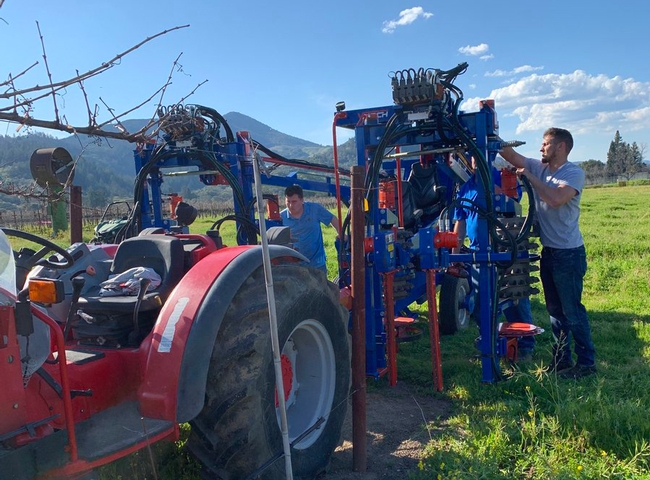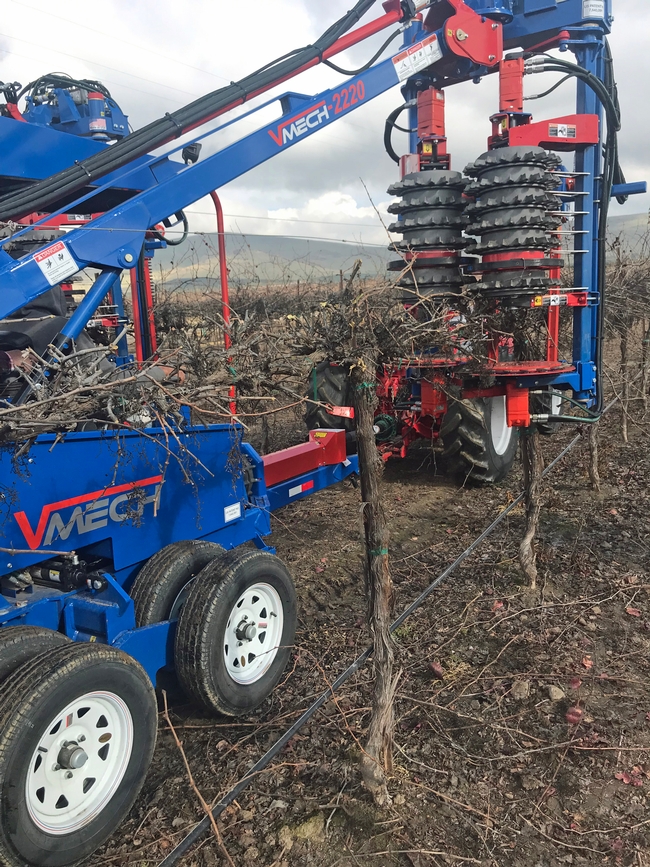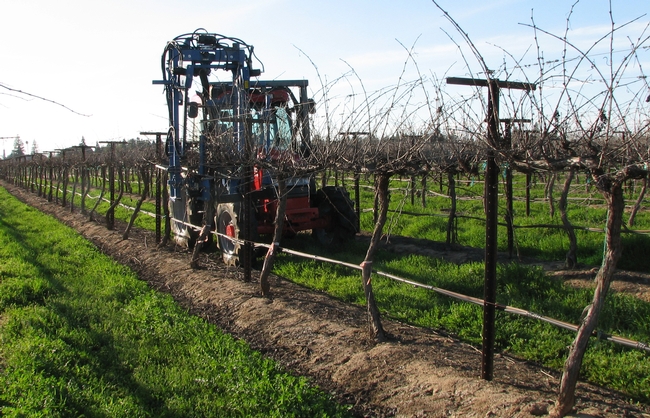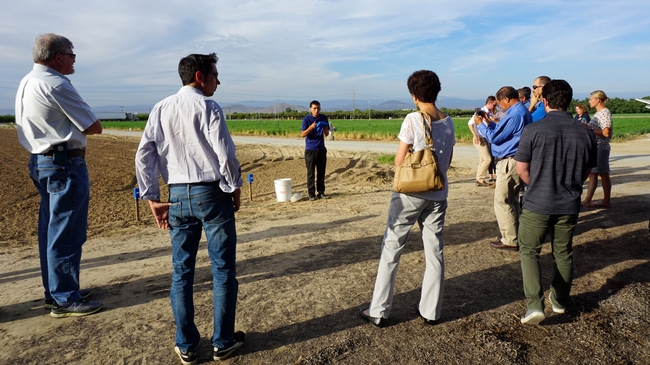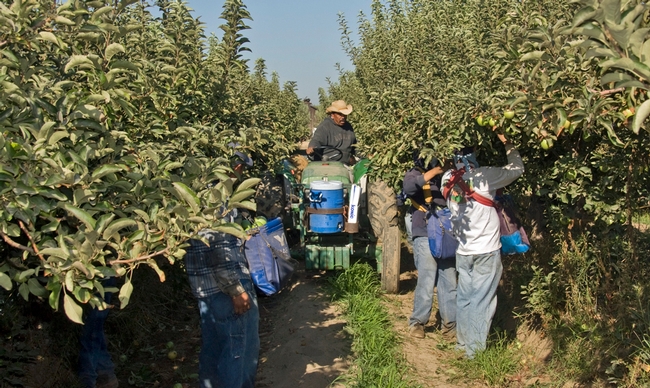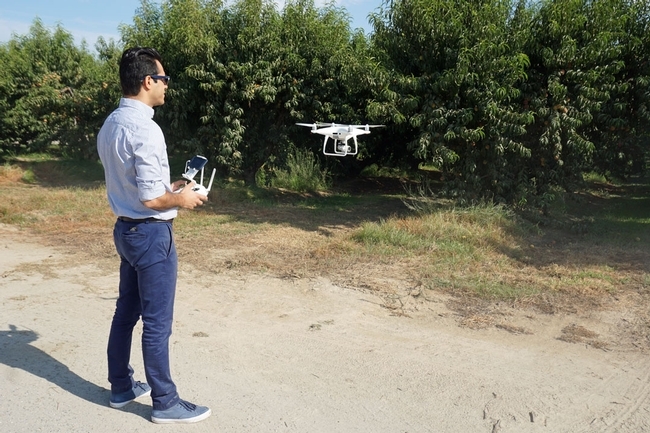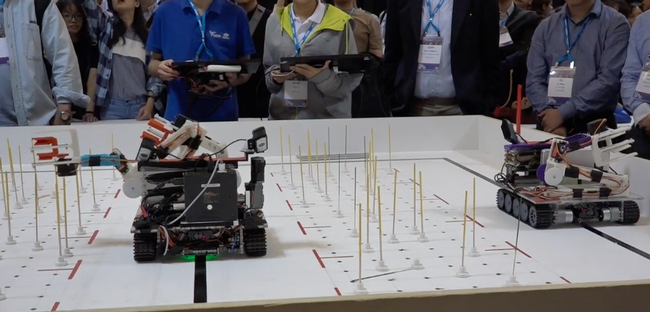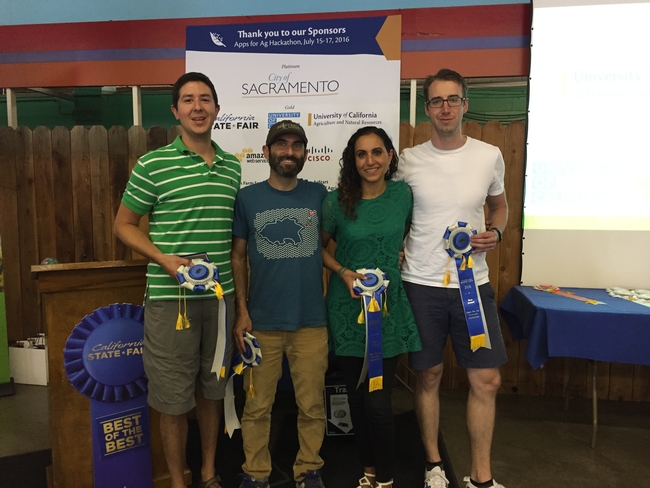- Author: Pamela Kan-Rice
Wine grape growers in the San Joaquin Valley who want to switch from hand pruning to mechanical pruning won't have to replant their vineyards to accommodate machinery, according to a new study published in HortTechnology by University of California Cooperative Extension researchers. Instead, growers can retrain the vines to make the transition, without losing fruit yield or quality.
Mechanical pruning reduced labor costs by 90%, resulted in increased grape yields and had no impact on the grape berry's anthocyanin content. That's welcome news for growers because the cost of re-establishing a vineyard in the region is roughly $15,600 per acre.
“We found that growers do not have to plant a new vineyard to mechanize their operations,” said Kaan Kurtural, UC Cooperative Extension specialist in the UC Davis Department of Viticulture and Enology. “We have proven beyond a doubt that an older vineyard can be converted to mechanization. There is no loss in yield during conversion and post-conversion yield is better and fruit quality is equivalent to or better than hand-managed vines. The economies of scale are evident in the savings per acre and per vine as depicted in the balance sheet provided with the newly published paper.”
The research was conducted in an 8-acre portion of a 53-acre, 20-year-old Merlot vineyard in Madera County. After completion of the research project, the grower converted the rest of the 53-acre vineyard to single high-wire sprawling system. Many other wine grape growers have followed suit.
The Wine Group, which manages 13,000 acres of vineyards across Central California, is establishing new vineyards and converting old vineyards for mechanical pruning and suckering, said vineyard manager Nick Davis. Davis, who works closely with Kurtural and the UCCE viticulture advisor in Fresno County, George Zhuang, said the company greatly values the UC Cooperative Extension research that is guiding the changes.
“I think extensionists are undervalued,” Davis said. “We lean on them for applied research, which has been wonderful. They offer us what we can't provide ourselves.”
More than half of all California wine grapes are grown in the San Joaquin Valley. Worker shortages, rising labor costs, low returns and occasional droughts are driving wine grape growers to seek innovative ways to sustain their businesses.
“To help growers maintain the profitability of their vineyards, we're studying the use of machines to reduce the number of people needed to perform tasks like pruning,” Zhuang said.
“Because the canopy architecture and yield characteristics of mechanically pruned vines are different from vines that are hand-pruned, the water and fertilizer requirements for the mechanically pruned vines can be quite different. So we are studying the yield and fruit quality of grapes produced on different rootstocks in mechanical pruning systems in the San Joaquin Valley,” Zhuang said.
The Madera field study was conducted for three consecutive seasons in the hot climate conditions typical of the San Joaquin Valley. In this area, traditional vineyards are head-trained to a 38-inch-tall trunk above the vineyard floor and two eight-node canes are laid on a catch wire in opposite directions and two eight-node canes are attached to a 66-inch high catch wire. Although this traditional training system can work for mechanical harvesting, it doesn't accommodate mechanical dormant pruning and shoot removal with limited success in other mechanical canopy management operations.
To accommodate mechanical pruning and shoot removal, the vines were converted to a bilateral cordon-trained, spur-pruned California sprawl training system, or to a bilateral cordon-trained, mechanically box-pruned single high-wire sprawling system.
The latter option proved to be the most successful system for mechanical pruning in the San Joaquin Valley.
- Author: Jeannette E. Warnert
The Third Annual Open Farm comes to the UC Kearney Agricultural Research and Extension Center in Parlier Oct. 3. Open Farm is a gathering hosted each year by the farming community to connect technology vendors, academics and growers to accelerate the digital transformation of the food and agriculture sector.
The meeting runs from 8:30 a.m. to 1:30 p.m. Registration is free for growers and government employees; $20 for representatives of power and water utilities; and $40 for vendors. Register on the Eventbrite webpage. (https://www.eventbrite.com/e/3rd-annual-open-farm-tickets-48793567875) Continuing education credits will be offered.
The Kearney REC is at 9240 S. Riverbend Ave., Parlier, Calif.
The Open Farm event features:
- Keynote address by Glenda Humiston, vice president, UC Agriculture and Natural Resources
- Field demonstrations of 3D mapping of research fields using drones, automation of irrigation and fertigation, and comparison of water measurement methods to prepare for the Sustainable Groundwater Management Act
- Peer reviewed research presentations on agronomy, monitoring, robotics and data mining
- An industry panel with growers and food processors
Open Farm 2018 sponsors and partners are:
- UC Agriculture and Natural Resources (UC ANR)
- The VINE, Verde Innovation Network for Entrepreneurship
- West Hills College, Coalinga
- California State University, Fresno
- BlueTechValley
- PowWow Energy
- WiseConn Engineering
- Pumpsight
- Blue River Technologies
- Bowles Farming Company
Open Farm started in 2016 at Terranova Ranch with the support of a research grant from the California Energy Commission (EPC-14-081). In 2017, the event grew to a wider gathering with peer-reviewed presentations organized by UC ANR and field demonstrations led by West Hills College. Both organizations are involved in the broadband initiative to bring better broadband services in the Central Valley.
“The future of ag tech innovation and implementation on the West Side depends on access to broadband internet in the fields,” said Terry Brase, ag science instructor at West Hills Community College. “West Hills is proud to partner with UC ANR to champion an initiative that would make this possible for local growers.”
PowWow Energy, Pumpsight and WiseConn Engineering are examples of companies that have worked with the farming community and established application programmable interfaces (API) that allow farmers to protect their data and get the different applications to talk to each other.
“It makes the lives of growers easier, not harder,” said Olivier Jerphagon, founder and CEO of PowWow Energy, Inc.
The three vendors went through the Water Energy Technology (WET) center at Fresno State, which is one of the incubators in California connected by the VINE.
“Agriculture needs standards to support the better integration of systems and data to make using technology easier and less expensive, while protecting the privacy of farms,” said Gabe Youtsey, UC ANR chief innovation officer. “We need to work together across industry, academia and government to share best practices and form partnerships to solve real problems and adapt the integration of software and data to the needs agriculture. This is why we started the VINE.”
The VINE – the Verde Innovation Network for Entrepreneurship – is a connected community of innovators and resources that sustainable agriculture and food innovators can leverage, including incubators, research labs, field testing facilities, mentors and industry experts.
“The food and agriculture industry is changing fast, and for an organization like ours to add value, we have to understand the diversity of innovation that is happening in the industry,” said Helle Petersen of Fresno State's WET Center. “The VINE community helps us navigate the field, and leverages the many assets of our region. The Open Farm is one of those opportunities, a unique event that brings together researchers, farmers, industry and others to share their knowledge, best practices and find opportunities for partnerships.”
- Author: Pamela Kan-Rice
Nineteen teams of college students from top universities in the U.S., Canada and China will compete to build robots to mechanize farm work at the American Society of Agricultural and Biological Engineers Annual International Meeting in Detroit.
The 2018 ASABE Student Robotics Challenge, being organized by Alireza Pourreza, University of California Cooperative Extension agricultural mechanization specialist, will be held on July 31.
“The labor availability for agriculture is decreasing while the need for more food is increasing to feed the growing world population,” said Pourreza, who is based in the UC Davis Department of Biological and Agricultural Engineering. “So agriculture should switch to technologies that are less labor-dependent, such as using more robots, to overcome this challenge.”
The ASABE Student Robotics Challenge provides an opportunity for undergraduate and graduate students to demonstrate their knowledge and skills of robotics in agriculture.
“The goal of this event is to encourage young agricultural engineers to get involved in building robots for agricultural applications and to get experienced as the next generation of farmers,” Pourreza said.
The challenge will be to simulate the harvest and storage of apples, a crop commercially grown in several states. The students will design and operate robots that will autonomously harvest “apples” on field that measures 8 feet by 8 feet. The robots will harvest eight mature apples (red ping-pong balls), remove and dispose of eight diseased or rotten apples (blue ping-pong balls) and leave eight immature apples (green ping-pong balls) on the tree.
This year, the competitors are being divided into a beginner division and an advanced division.
Beginner Teams
California Polytechnic State University Green and Gold Mustangs
China Agricultural College China Ag, Beginners
McGill University We Are Groots
Purdue ABE Robotics
Purdue Harvestiers
Texas A&M Texas A&M
University of California Merced Bobcats
University of Nebraska Lincoln HuskerBots 2
University of Nebraska Lincoln HuskerBots3
University of Wisconsin River Falls Falcon Robotics
Zhejiang University ZJU team 1
Zhejiang University ZJU team 2
Clemson University CARA
Advanced Teams
China Agricultural College Dream
McGill University Agrobots
University of Georgia UGA Engineers
University of California – Davis Ag-Botics
University of Florida RoboGators
University of Nebraska Lincoln HuskerBots 1
The competition will be held in Cobo Center Exhibit Hall, 1 Washington Blvd., Detroit, Michigan. There will be three rounds throughout the day and each team will participate once in each round.
For more information, visit the 2018 ASABE robotics competition website: https://www.asabe.org/Awards-Competitions/Student-Awards-Competitions-Scholarships/Robotics-Student-Design-Competition.
Video of 2016 competition: https://www.youtube.com/watch?v=U1ymUiCr3Mc
Video of 2017 competition: https://vimeo.com/250379863
- Author: Pamela Kan-Rice
A gardening and produce-sharing app took top prize in the Apps for Ag hackathon, after contestants pitched judges at the California State Fair in Sacramento on Sunday (July 17). The first place team, GivingGarden, took home $7,500 in prize money, custom rodeo belt buckles and a six-month, top-tier membership to the AgStart Incubator in Woodland.
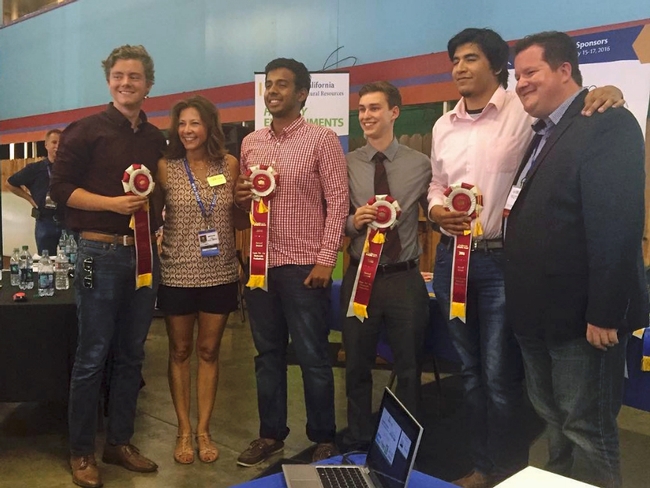
Second place was awarded to Sense and Protect, a mobile task-management app that connects to climate sensors to protect farmworkers' health and enhance their productivity. Sense and Protect team members Dhrubajyoti Das, Alex Avalos, Anthony Johnson and Peter Swanson share $4,500.
Third place went to ACP STAR System, a geo and temporal database and platform for tracking Asian citrus psyllid and other invasive pests. Team members Mark Takata and Chinh Lam share $2,500.
The top three teams will also receive complimentary startup incorporation services valued at $2,200 from Royse Law.

All of the participating teams had about 48 hours to develop their apps. Teams that were interested were offered $500 in “cloud credits” to build their solutions and host them on Amazon Web Services' platform. Teams also had access to an IoT kit to incorporate connected devices into their solution.
The top four teams pitched their apps to judges in front of a live audience at the California State Fair.
The Apps for Ag hackathon, which was sponsored by UC Agriculture and Natural Resources, the California State Fair and the City of Sacramento, brought together software developers, designers, entrepreneurs, farmers and others who work in agriculture.

“Using technology we can find better ways to reduce pesticide use, increase irrigation efficiency, reduce travel into the fields, manage people better, and deal with the fact that we have a huge labor shortage in this state,” said Humiston, who served as one of the Apps for Ag judges.
The other judges included University of California Chief Information Officer Tom Andriola, USDA Chief Data Officer Bobby Jones, and Better Food Ventures and Mixing Bowl Hub founder Rob Trice.
For more information about Apps for Ag, visit http://www.apps-for-ag.com.
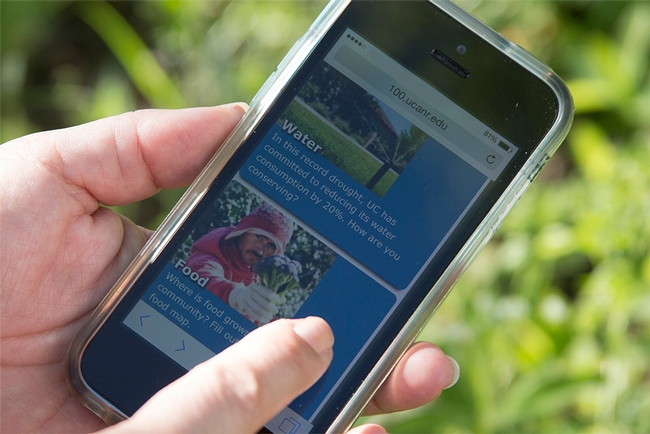
Do you have an idea for a mobile app that would simplify a task for growers, ranchers or anyone who works in agriculture? Meet others who can turn your idea into something functional.
The California Apps for Ag, the fourth in a series, will be held July 15-17. The competitive hackathon to solve real problems in agriculture and food is being hosted by UC Agriculture and Natural Resources and the California State Fair.
Software developers, designers, entrepreneurs, farmers, farm consultants and others in the agricultural industry are encouraged to participate in the hackathon, which will be held at the UC Agriculture and Natural Resources building at 2801 Second Street in Davis, from 8 a.m. Friday, July 15 to 11 a.m. Sunday, July 17.
Participants will compete for cash prizes at a “pitchfest” in front of a live audience at the California State Fair on Sunday, July 17, from 1 p.m. to 3 p.m. Prizes will be awarded to the top three apps: first place wins $5,000, second place $3,000 and third place $1,500.
“We would really like to see participants come from all corners of the state,” said Gabe Youtsey, UC ANR's chief information officer, “Let's see what happens when we mix developers from Silicon Valley and Southern California with agricultural experts from the Central Valley, coast and desert regions.”
People who work in agriculture should bring ideas for problems that technology may help solve.
“Apps for Ag Hackathons have already resulted in multiple startups and we want to see this momentum continue to grow,” said Robert Tse, USDA California Rural Development chief strategy officer for agriculture technology and innovation. “There is no better place than the State Fair in the Capitol to showcase the ingenuity of California's ag tech community.”
One startup that has resulted from a previous ag hackathon is Ag for Hire, which connects farm workers who need jobs with farmers who need workers.
“Apps for Ag is where I met my cofounder, formed the concept and built our first prototype,” said Josh Brown, Ag for Hire founder and CEO. “I would not have been able to find someone so embedded in the agriculture industry on my own.”
“Hackathons are a great way to spur innovation in industry verticals where technology has not been fully adopted,” said Rob Trice, one of the judges and the founder of the Mixing Bowl and Better Food Ventures.
“All roads already point to the State Fair's competitions for other agricultural commodities,” said Jay Carlson, ag programs manager at the State Fair, “This makes the fair a showcase for agricultural innovations as well.”
For more information and to register, visit http://www.apps-for-ag.com.
About Apps for Ag
Apps for Ag is a pro-bono endeavor supported by several AgTech hubs around California, and founded by the AgTech Roundtable, whose members include U.S. Department of Agriculture, California Department of Food and Agriculture, California Department of Technology, California Farm Bureau Federation, California Association of Pest Control Advisers and many other organizations.
UC Agriculture and Natural Resources researchers and educators draw on local expertise to conduct agricultural, environmental, economic, youth development and nutrition research that helps California thrive. Learn more at ucanr.edu.
MEDIA CONTACTS:
Patrick Dosier, Apps for Ag, (714) 504-5424, info@apps-for-ag.com
Gabe Youtsey, UC Agriculture and Natural Resources, (530) 750-1314, gdyoutsey@ucanr.edu

